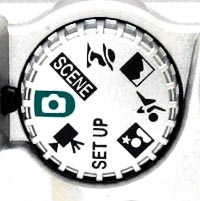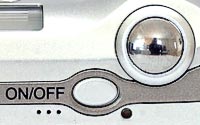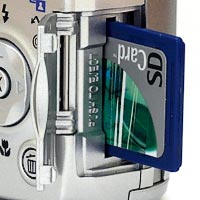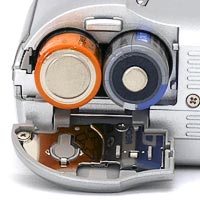Nikon Coolpix 7600
Review Date: May 26th 2005
|
Ease of Use
The Nikon Coolpix 7600 is a very compact, light and well-made digital camera that has a "quality" feel about it. At nearly 9cms long and 6 cms high, the Nikon Coolpix 7600 easily fits into the palm of my large hands and is therefore a pocketable camera that you can carry with you at all times. The Nikon Coolpix 7600 is constructed entirely of plastic with a brushed silver finish. There is also a thin grey metal band that runs around both sides and the top of the camera, presumably there to help keep the overall design rigid and stop it from flexing.
The Nikon Coolpix 7600 strikes the right balance in terms of the number of external controls on the camera, with 9 in total, perfect for its target audience. There are just enough to give you full control over the important aspects of the Nikon Coolpix 7600, but not so many that you're left wondering which one does what. The Nikon Coolpix 7600 instantly feels intuitive to hold and use. There's a traditional dial on the rear of the camera that lets you select the different exposure modes; Auto, various Scene modes, Movie mode and also the Setup menu. This dial is a typical feature of SLR cameras, and enables you to quickly change between the various modes. The only aspect of the external controls that I found initially confusing was the symbol for data transfer when the camera is connected to a computer, represented by OK and a wavey line with two arrows on either end. I'm never seen this symbol on any other camera and am not sure that it is really required, especially as the Nikon Coolpix 7600 automatically connects to a computer anyway.
Like virtually all digital cameras the Nikon Coolpix 7600 has a Menu button on the rear of the camera which, as you would expect, gives you access to the software menu system. This lets you set various parameters including continuous modes, exposure compensation and white balance. The main gripe that I have with accessing the Nikon Coolpix 7600's menu system was that once you are viewing it, you can't turn it off by half-pressing the shutter button, which a lot of other digicams allow you to do. Instead you have to press the Menu button again to turn the menu off. This is fine when you're not in any particular hurry to take a shot, but if the crucial moment is happening in front of you, your first instinct will be to press the shutter button - except on this camera, it won't let you take the shot, instead belligerently displaying the menu system! This is also true of the Play button - if you are reviewing your image onscreen and want to take a shot, you have to press the Play button to cancel out of that mode.
| Exposure Mode Dial | Shutter Button / On/Off Button |
 |
 |
Something else that may initially confuse you is the way in which the Setup menu is accessed. It has its own dedicated setting on the shooting mode dial on the rear of the camera, rather than being accessed via the Menu button as on most digital cameras. This didn't really bother me once I had got used to it, it's more something to be aware of if you have previously used a digicam from a different manufacturer.
One other aspect of the shooting mode dial that requires further explanation is the way in which the scene modes are accessed. There are 4 icons on the dial, which allow you to select Portrait, Landscape, Sports and Night Portrait modes. Pressing the Menu button when any of these are selected displays a number of options on the LCD screen for that particular mode. For example, choosing Landscape and pressing the Menu button displays 5 options, each one for a specific kind of landscape scene (Landscape, Scenic View, Architecture, Group Right, Group Left, plus options to change the image quality and size). There is also a Scene option on the shooting mode dial, which lets you choose from 12 other different scene modes, such as Beach and Snow. Unlike the main four scene modes, these don't have any sub-options via the Menu button. Accessing the Scene Modes in this way is a neat system that works well in practice.
Pressing the Menu button on the Nikon Coolpix 7600 when the shooting mode is set to Auto opens the Shooting Menu, a 2 screen scrolling list that contains 6 different options, including White Balance, Continuous and Best Shot Selector. A maximum of 5 options is shown onscreen at once, with a large clear font and a useful icon for each option on the right-hand-side. If you are unsure of what a particular option does, press the Help button on the rear of the camera to display a short but helpful explanation. For Continuous, the Help tells you "Keep the shutter-release button pressed to take pictures continuously". The Help system on the Nikon Coolpix 7600 isn't as advanced as the system on HP's digital cameras, but it will prove quite useful for less experienced photographers who have left the manual at home.
The Coolpix 7600 is one of the first Nikon cameras to feature two new technologies which Nikon have been promoting heavily since the PMA show back in February 2005 where they were first unveiled. These are D-Lighting, Face Priority AF and Red-Eye Reduction. Do they actually work?
Face Priority AF is accessed by selecting the Portrait option on the shooting mode dial, pressing the Menu button and then choosing the Face Priority AF option on the bottom row. It works well if the subject is looking directly at the camera and quite central in the frame, but in most other situations the camera hunts for focus for several seconds and then tends to focus somewhere other than the subject's face. I suspect that most users will quickly lose patience with this feature, as will the person who is being photographed!
Red-Eye Reduction promises to remove all traces of red-eye in-camera and D-Lighting is similar to HP's Adaptive Lighting technology, in that it lightens under-exposed parts of the image whilst ensuring that correctly exposed parts remain the same (and are not also lightened) - more on these features in the Image Quality section.
| Memory Card Slot | Battery Compartment |
 |
 |
The start-up time of the Nikon Coolpix 7600, from turning the camera on to being ready to take a photo, is fairly quick at around 1.5 seconds. The 3x zoom lens takes around 1.5 seconds to zoom from the widest focal length to the longest, but the zooming mechanism is very noisy, which doesn't make the Coolpix 7600 suitable for candid photography. Focusing is very quick in good light and competent indoors or in low-light situations, taking slightly longer to lock on to the subject at the telephoto lens setting. Shutter-lag is barely noticeable and storing an image is fairly quick at around 0.75 seconds. The 1.8 inch LCD screen is bright and clear and the refresh rate is fine. The Nikon Coolpix 7600 has a limited range of continuous shooting modes and a slow maximum shooting rate of 1.3 fps, which doesn't make it particularly well suited for fast moving subjects. All in all the Nikon Coolpix 7600 is a responsive compact digital camera in terms of its general operational speed, both in good and bad lighting conditions.
Once you have captured a photo, the Nikon Coolpix 7600 has an above average range of options for playing, reviewing and managing your images. You can scroll through the images that you have taken, view thumbnails, play a slideshow, and zoom in and out of the image up to a magnification of 10x. You can select which images you want to transfer onto your computer, delete an image, trim an image to a preset small size (with 3 different options), make a copy of an image, protect images so that they cannot be deleted, and set various printing options. There is no histogram available at any time when using the Nikon Coolpix 7600, which is an important missing feature that a lot of other digital cameras in this class have.
Overall the Nikon Coolpix 7600 is a simple to use, stylish and well-built digital camera with a few quirks that is ideally suited to photography of slow-moving subjects.
|
 PhotographyBLOG is a member of the DIWA organisation. Our test results for the Nikon Coolpix 7600 have been submitted to DIWA for comparison with test results for different samples of the same camera model supplied by other DIWA member sites.
PhotographyBLOG is a member of the DIWA organisation. Our test results for the Nikon Coolpix 7600 have been submitted to DIWA for comparison with test results for different samples of the same camera model supplied by other DIWA member sites.
